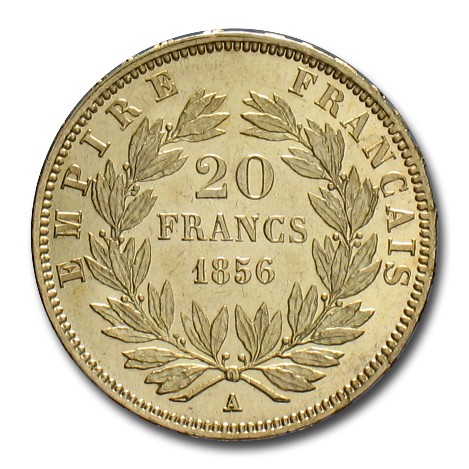The Marengo - Moruzzi Numismatica Roma
Main menu:
- An introduction to numismatics and collecting
- Abbreviations concerning coins
- Collecting ancient coins in Italy
- State of preservation of coins
- The rarity
- Numismatic bibliography
- False coins
- Plated coins
- The Roman woman in the portraits of the Augustae
- Roman tesserae with numerals and Spintriae
- The Ara Pacis
- The temple of Janus
- Domitianus
- A solidus of Jovinus
- International Coins
The Marengo


The Napoleon, or Marengo, is a gold coin with value of 20 francs, coined in 1801 in the Subalpine Republic to celebrate the victory of Napoleon Bonaparte against Austrians on June the 14th 1800. This type of coin was produced between 1803 and 1815, with a weight of 6,45 grams and a gold content of 900 milliseconds. On these coins there was the effigy of Napoleon Bonaparte, initially as First Consul and later as Emperor of France. After the fall of Napoleon, the production of coins of the same type continued and all gold coins with value of 20 francs, produced in France in nineteenth century, were called Marengo. After the establishment of the Latin Monetary Union, the name Marengo was extended also to other coins of the union with the same value, including the 20 Italian lire. The Latin Monetary Union was an attempt of nineteenth century to allow the free circulation of many European currencies within the member countries, when the coins value was represented by the quantity of the precious metal contained. The European Agreement was mainly based on the French monetary system. After the French Revolution, France adopted the new monetary system, named germinal franc, according to the law of Germinal the 18th Year III (April the 7th 1795) and of Germinal the 7th year XI (March the 27th 1803), based on a decimal system (1 franc = 100 centimes), a bimetallic monetary system in which both gold and silver were legal tender. The franc legal tender had a ratio between gold and silver metals equal to 15.5 more or less, that is a franc had a value of 4,5 grams of pure silver or 0,29025 grams of gold. The coexistence of both monetary standards (gold and silver) originated conditions for a potential source of instability. The germinal franc system was based on the invariance hypothesis about the price of gold and silver and it considered stable volumes, conditions and production costs of the two metals. Because of these circumstances, a crisis of this system would be possible at any time. Chaired by Félix de Esquirou de Parieu, the Latin Monetary Union "was signed" on December the 23rd 1865. The Convention established these following principles:
- The monetary standardization: each signatory country was obliged to issue coins according to the defined rules, but it could continue to call its coin with the previous name.
- The integral bimetallism: the minting of gold and silver was free and the releasing power was unlimited. Every citizen was obliged to accept, without restrictions, gold and silver coins of 5 francs minted according to the agreement of the Union; also, the coins of each state were legal tender within the Union (with a ceiling for divisional silver coins).
The success of the Latin Monetary Union, because of the number of countries adopting the system (32 altogether), created the conditions for an international monetary system. The signatory countries were France (1865), Belgium (1865), Italy (1865), Switzerland (1865) and Greece (1868); the associated countries with bilateral agreements such as Austria-Hungary, Sweden, Russia, Finland, Romania, Spain, the Papal State, San Marino, Liechtenstein, Monaco and Crete. The unilaterally aligned countries were: Serbia, Bulgaria, Venezuela, Peru, Dominican Republic, Haiti, the Danish West Indies, Argentina, Brazil and Chile. There were also the countries under the colonial statute as Tunisia, Comoros, Congo, Puerto Rico and Eritrea. Also United States were intentioned to join to the Latin Monetary Union in 1873, but the Congress finally decided to maintain its ratio of gold and silver at 16 against the 15.5 of the Union. The Union's functioning was essentially weak for two problems: the floating of the relative relation between the two metals, considered stable at the beginning, and the exchange one. The changing relationship between metals made impossible to continue minting money. After the First World War, the situation was no longer sustainable as, according to the treaty, it was not allowed to coin money. At the end of 1925, Belgium first denounced this situation and the Convention - which had the most representative coins no longer minted as the Napoleon and the écu of five francs - was formally dissolved on January the 1st 1927.
The perceived ideas of an individual are unique and a logical product of different and personal impressions. Although a great deal of intellectual comment is placed freely on the internet, it should not be forgotten that there are moral and legal obligations with respect to the plagiarising of text without the consent of the author. Copyright Moruzzi Numismatica © 1999-2016